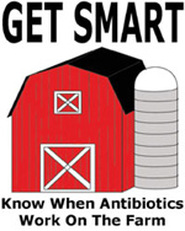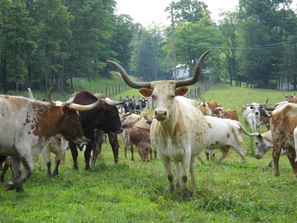 Pop Quiz: Who consumes the most antibiotics in this country? A. Humans B. Livestock (including the animals we eat) C. Cousin Bob, he's always sick with something It has been reported that more antibiotics are consumed by our farm animals than by humans in the US. Our last blog post discussed the efforts of the the Center for Disease Control (CDC) to help physicians reduce the use of antibiotics for children and adults. Unfortunately, the farm industry has been slower to respond. The CDC reported in 2005, "In the United States, data on the quantity of antibiotics given to food animals is not available to the public or to government agencies. According to the Union of Concerned Scientists, about 25 million pounds of antibiotics and related drugs are used every year in livestock for nontherapeutic purposes. The Animal Health Institute estimates that 20.2 million pounds of antibiotics were produced for use in farm and companion animals in 2003." Why are so many antibiotics being used on farm animals (and what are "nontherapeutic purposes")? The CDC reports, "Antibiotics are used in food-producing animals for three major reasons:
Do you notice anything odd here? While doctors recommend humans take antibiotics only when they are sick with a bacterial infection, our animals are given antibiotics to prevent infections and to cause them to gain weight (more pounds = more $$$). Often farmers are not therapeutically treating sick animals. They are using antibiotics to fatten up animals quicker, and as an easy way to keep them from becoming sick. The Union of Concerned Scientists notes, "This type of 'disease prevention' is a crutch that allows [factory farm] operators to avoid good husbandry practices that could avoid and manage disease outbreaks responsibly, and is the ideal breeding ground for antibiotic-resistance." Based on the CDC's information above, we can assume the farms using antibiotics to fatten their animals must not provide "animal production settings with good sanitation", otherwise this wouldn't work. A sanitary environment seems like a reasonable "good husbandry practice" to expect from farms. Other issues involve crowding the animals in limited space and feeding them unnatural foods (primarily corn-based diets) that tend to bring on these diseases. Because of increasing antibiotic use, the CDC is concerned about growing resistance to antibiotics and started "Get Smart: Know When Antibiotics Work On The Farm". The CDC notes, "Antibiotic resistance is a food safety problem for several reasons:
 These healthy cattle are grown locally without antibiotics. How do resistant bacteria spread from animals to humans? The CDC notes, "Resistant bacteria may be transferred to humans through the food supply or direct contact with animals. For example, Campylobacter lives in the intestines of chickens. People get Campylobacter diarrhea primarily from eating undercooked chicken. In 1989, none of the Campylobacter strains from ill persons that CDC tested were resistant to fluoroquinolone antibiotics. In 1995, the FDA approved the use of fluoroquinolones in poultry. Soon afterwards, doctors found Campylobacter strains from ill persons that were resistant to fluoroquinolone antibiotics." What does the CDC say about this health risk? "The use of antibiotics to promote growth is widespread in food animal production. Antibiotics used for growth promotion increase the pressure for bacteria to become resistant. To address this public health problem, the World Health Organization (WHO) has recommended that antibiotics not be used for this purpose. It is determined that this practice is unsafe for the public's health (World Health Organization)." There is growing agreement that farmers should at least stop using antibiotics as a cheap way to fatten their livestock, and we may see legislation to stop this. It will be harder to convince factory farms to give up using antibiotics as a preventive health measure. They would have to provide a more sanitary environment with more space for the animals and provide healthier feed to keep them from becoming sick. That costs money. The best way to encourage positive change is by avoiding meat grown with antibiotics. We recommend looking for meat that is grown without antibiotics (or hormones) to avoid any potential harm to your health. Organic foods are grown without the chemicals or medication. Pasture-raised or grass fed animals are even better. Farms will only produce what sells, so buy the good stuff. Find more information about this topic on the CDC's website.
1 Comment
Dr Aaron McMichael
5/3/2012 07:02:17 am
Since the posting of this article, a federal court judge has ruled that the FDA must act on its decades-old plan to address the dangers of antibiotic overuse in farm animals. The FDA has reported the issue years ago and research demonstrates a real concern, but little had been done.
Reply
Your comment will be posted after it is approved.
Leave a Reply. |
Details
THE NATURALS
AuthorsDr Aaron McMichael + Dr Ryan McMichael Categories
All
Archives
June 2025
_Information and statements made are for education purposes and are not intended to replace the advice of your treating doctor. This blog is not a doctor and will not diagnose or treat your problems.
|
 RSS Feed
RSS Feed